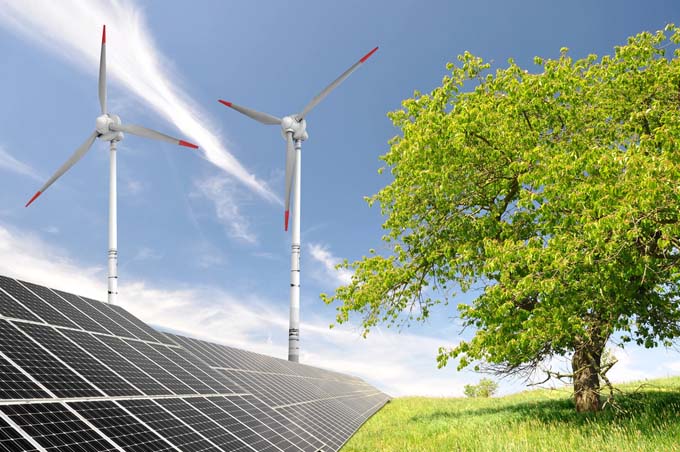Decentralized heat pumps bring great advantages
Living quality at the gates of Zurich: In the ABZ housing estates Felsenhof and Talstrasse with 69 apartments, the heat for space heating and hot water comes from the ground. There are 18 geothermal probes and 8 heat pumps in use.

The building cooperative has renovated the 50-year-old Felsenhof 2 housing estate to make it more energy-efficient. Photo: Reto Schlatter
Local heating network with structural weaknesses
For decades, the four settlements in the Felsenhof area were supplied by a star-shaped local heating network with central heat generation. Gas boilers were used. However, the pipe network was leaking and the heat losses were too high. A complete replacement of the network is obvious, but under current conditions it is not the optimal solution. The "Felsenhof" example illustrates the correlation between networking and energy efficiency. It is a question of weighing up the network costs against the cost of an additional heating center. For the site in Adliswil, the following applies: Neither complete networking with a heating center nor completely decentralized heat generation is the solution, but rather a mixture of networking and decentralization.The ideal mix
Today, eight heating centers supply heat for the 93 apartments. Heat pumps (HP) are installed in six central heating units, and two gas boilers remain in operation in the "Adliswil alt" housing estate. With the exception of the Felsenhof 1 housing estate, only directly adjacent buildings are networked. This makes the heating network significantly smaller. In Felsenhof 1, the extensive networking is obvious due to the terraced single-family houses. The electronic monitoring of the heating centers facilitates the work of the maintenance service. This applies above all to the control system and fault reporting with diagnostics. This automatic system does not require complicated equipment. This is another reason why the non-profit cooperative ABZ, as the building owner, demands simple and clear building services infrastructures from the planning teams. This applies in particular to the control and regulation of heat generation.Earth probes - carefully dimensioned
According to the new version of the standard SIA 384/6 Geothermal probes, fields with more than four probes have to be simulated. This simulation was carried out using the EWS program from Huber Energietechnik, which is recognized by the authorities. The specific extraction power of the borehole heat exchanger (see table below) plays a central role in the dimensioning of the borehole heat exchanger. For decades, 50 W/m was considered a guide value. Higher values can lead to cooling of the surrounding soil, if no regeneration is possible. The average value of 36.4 W/m, weighted according to the length of the probes, shows that the planners guarantee a very long-term solution.
Thermal insulation has a positive effect
Due to the relatively good quality of the building envelope, heat consumption is at a moderate level, which is also evident from the low installed heating capacity of 38.6 watts per m2 of energy reference area. The flow temperatures of 50 °C and 52 °C respectively at an outside temperature of -8 °C enable efficient operation of the heat pumps. Only the hot water has to be heated to 55 °C, once a week to 60 °C. The water is heated either by the heating HP or by separate hot water HP. This guarantees short distribution lines. Favorable apartment rents are part of the ABZ tradition. This goal, combined with climate protection, has a significant impact on planning work. Therefore, tight cost limits apply to the conversion of housing estates to renewable energies. The Felsenhof site shows very clearly that this combination works. When deciding on a heating system, the ABZ always compares different variants. The focus is on a high proportion of renewable energies, but also on cost-effectiveness. In this project, the cooperative used subsidies from the KliK foundation, which also had a dampening effect on the investment costs. The contribution was realized on behalf of the KliK Foundation.Other topics: The contribution Decentralized heat pumps bring great advantages first appeared on Environment perspectives.Energy Future Switzerland and Klik Foundation
In partnership with the Climate Protection and CO2 Compensation Foundation KliK, the heat pump subsidy program of Energie Zukunft Schweiz (EZS) provides financial contributions to heat pumps that serve to replace fossil fuel heat generators. This "climate premium" paid by EZS is often much more attractive than the subsidies provided by the cantons, especially for larger systems. The decisive factor for the contributions is the CO2 reduction triggered by the project. Converted to the annual energy consumption of the heating system, it is 18 centimes per kWh, which corresponds to Fr. 1.80 per liter of heating oil. The climate premium can be converted to the heating capacity via the full load hours. A 50 kW unit with 2000 full load hours is subsidized with Fr. 18 000. The subsidy conditions are available at www.klik.ch/waerme or www.energiezukunftschweiz.ch/klimapraemie noted, the registration is very simple. The program leader is Nico Pfäffli.









